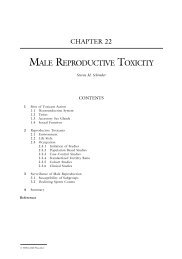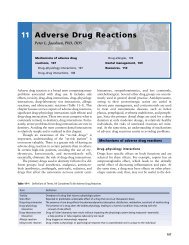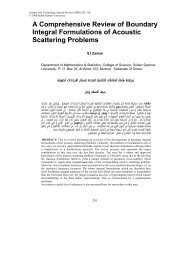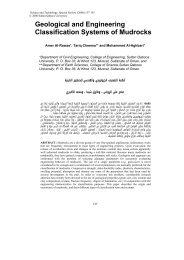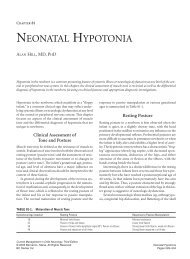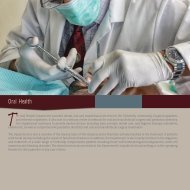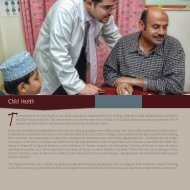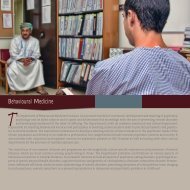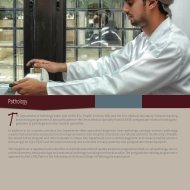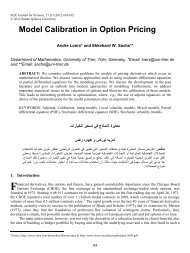Ch05: Red and White Lesions of the Oral Mucosa
Ch05: Red and White Lesions of the Oral Mucosa
Ch05: Red and White Lesions of the Oral Mucosa
You also want an ePaper? Increase the reach of your titles
YUMPU automatically turns print PDFs into web optimized ePapers that Google loves.
<strong>Red</strong> <strong>and</strong> <strong>White</strong> <strong>Lesions</strong> <strong>of</strong> <strong>the</strong> <strong>Oral</strong> <strong>Mucosa</strong> 117<br />
A B<br />
FIGURE 5-44 <strong>Red</strong> geographic tongue seen in patients with pernicious anemia. A, Typical red lesions involving <strong>the</strong> dorsum. B, Typical red lesions involving<br />
<strong>the</strong> ventral tongue.<br />
considered a major factor as well. Importantly, poor oral<br />
hygiene can exacerbate this condition. The common etiologic<br />
factor for all <strong>of</strong> <strong>the</strong>se influences may be <strong>the</strong> alteration <strong>of</strong> <strong>the</strong> oral<br />
flora by <strong>the</strong> overgrowth <strong>of</strong> yeast <strong>and</strong> chromogenic bacteria. 283<br />
(See Chapters 4 <strong>and</strong> 7 for a more thorough discussion <strong>of</strong> this<br />
entity <strong>and</strong> its treatment.)<br />
Hairy tongue usually involves <strong>the</strong> anterior two-thirds <strong>of</strong> <strong>the</strong><br />
dorsum <strong>of</strong> <strong>the</strong> tongue, with a predilection for <strong>the</strong> midline just<br />
anterior to <strong>the</strong> circumvallate papillae. The patient presents with<br />
elongated filiform papillae <strong>and</strong> lack <strong>of</strong> desquamation <strong>of</strong> <strong>the</strong><br />
papillae. The tongue <strong>the</strong>refore appears thickened <strong>and</strong> matted.<br />
Depending on <strong>the</strong> diet <strong>and</strong> <strong>the</strong> type <strong>of</strong> organisms present, <strong>the</strong><br />
lesions may appear to range from yellow to brown to black or<br />
tan <strong>and</strong> white. Although <strong>the</strong> lesions are usually asymptomatic,<br />
<strong>the</strong> papillae may cause a gag reflex or a tickle in <strong>the</strong> throat if <strong>the</strong>y<br />
become especially elongated (Figure 5-45). They may also result<br />
in halitosis or an abnormal taste. A biopsy is usually unnecessary.<br />
Treatment consists <strong>of</strong> eliminating <strong>the</strong> predisposing factors<br />
FIGURE 5-45 Elongated papillae in a patient with black hairy tongue.<br />
Such papillae can sometimes cause gagging <strong>and</strong> irritation <strong>of</strong> <strong>the</strong> palate.<br />
if any are present. Cessation <strong>of</strong> smoking or discontinuation <strong>of</strong><br />
oxygenating mouthwashes or antibiotics will <strong>of</strong>ten result in<br />
resolution. Improvement in oral hygiene is also important,<br />
especially brushing or scraping <strong>of</strong> tongue, in addition to o<strong>the</strong>r<br />
good oral hygiene practices. Podophyllin resin (a keratolytic<br />
agent) has been used in treatment, but <strong>the</strong>re are some questions<br />
about its safety. However, a 1% solution <strong>of</strong> podophyllin resin is<br />
available for <strong>the</strong> treatment <strong>of</strong> hairy tongue. The efficacy <strong>of</strong><br />
tooth brushing can be enhanced by a prior application <strong>of</strong> a 40%<br />
solution <strong>of</strong> urea. Topical tretinoin has recently been tried as<br />
treatment <strong>of</strong> this entity. 289,290<br />
<strong>Oral</strong> Submucous Fibrosis<br />
<strong>Oral</strong> submucous fibrosis (OSF) is a slowly progressive chronic<br />
fibrotic disease <strong>of</strong> <strong>the</strong> oral cavity <strong>and</strong> oropharynx, characterized<br />
by fibroelastic change <strong>and</strong> inflammation <strong>of</strong> <strong>the</strong> mucosa,<br />
leading to a progressive inability to open <strong>the</strong> mouth, swallow,<br />
or speak. 291,292 These reactions may be <strong>the</strong> result <strong>of</strong> ei<strong>the</strong>r<br />
direct stimulation from exogenous antigens like Areca alkaloids<br />
or changes in tissue antigenicity that may lead to an autoimmune<br />
response. It occurs almost exclusively in inhabitants <strong>of</strong><br />
Sou<strong>the</strong>ast Asia, especially <strong>the</strong> Indian subcontinent. 292–295 The<br />
inflammatory response releases cytokines <strong>and</strong> growth factors<br />
that promote fibrosis by inducing <strong>the</strong> proliferation <strong>of</strong> fibroblasts,<br />
up-regulating collagen syn<strong>the</strong>sis <strong>and</strong> down-regulating<br />
collagenase production. 292,296<br />
ETIOLOGY<br />
Even though <strong>the</strong> etiopathology is incompletely understood, several<br />
factors are believed to contribute to <strong>the</strong> development <strong>of</strong><br />
OSF, including general nutritional <strong>and</strong> vitamin deficiencies <strong>and</strong><br />
hypersensitivity to certain dietary constituents such as chili peppers,<br />
chewing tobacco, etc. 293 However, <strong>the</strong> primary factor is <strong>the</strong><br />
habitual use <strong>of</strong> betel <strong>and</strong> its constituents, which include <strong>the</strong> nut<br />
<strong>of</strong> <strong>the</strong> areca palm (Areca catechu), <strong>the</strong> leaf <strong>of</strong> <strong>the</strong> betel pepper<br />
(Piper betle), <strong>and</strong> lime (calcium hydroxide). Approximately 200<br />
million persons chew betel regularly throughout <strong>the</strong> western





